![]()
![]()
![]()
Use LEFT and RIGHT arrow keys to navigate between flashcards;
Use UP and DOWN arrow keys to flip the card;
H to show hint;
A reads text to speech;
37 Cards in this Set
- Front
- Back
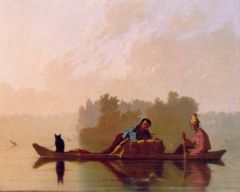
|
Gingham, "Fur Traders Descending the Missouri", 1845, American Romantiscism
exotic, fantasy emphasizes the stillness, calm, ONE with nature, not disturbing it horizontal lines=intense stability |
|
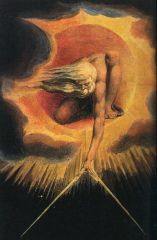
|
Blake, "Ancient of Days", 1800, Romanticism
spiritual, dark creating life with a compass, symbolic creator figure making his own religion +style didn't like structure was a poet (fusion of the arts) supernatural/revolt themes GOTHIK |
|

|
Blake, "Great Red Dragon", 1800, Romanticism
angel/devil imagery orant position, both have TONS of power Gothik supernatural making his own religion +style didn't like structure was a poet (fusion of the arts) |
|

|
Goya, "Portrait of IV", 1800, Early Romanticism
true state, gently poking fun royal family liked it because they looked rich and powerful Dumb king, Maria Louisa=real powerhouse |
|
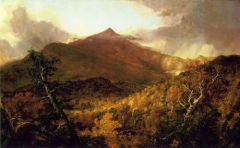
|
Cole, "Shroon Mountain", 1830, American Romanticism
new eden, frontier, advertisement for colonization change of seasons=super american uniquely american landscape/universally comprehensible has little tiny indians, shows power of nature |
|
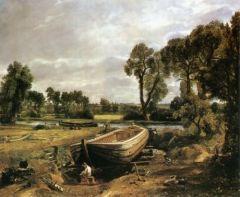
|
Constable, "Boat-Building near Flatford Mill", 1830, Romanticism
building of traditional transportation, pre-industrial revolution nature/power people are small |
|
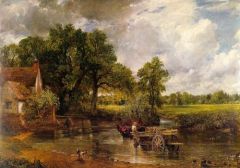
|
Constable, "The Hay Wain", 1830, Romanticism
Use of traditional transportation, pre-industrial revolution nature/power people are small agains the filth of cities |
|
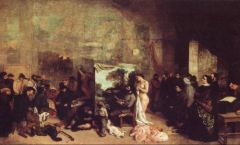
|
Courbet, "Artist's Studio", 1850, Realism
"a real allegory summarizing my seven years of life as an artist" playing off of traditional studio painting, Courbet is in center surrounded by every day people "real allegory" because he doesn't paint ANYTHING unless he sees it |
|
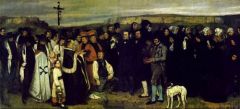
|
Courbet, "Burial at Ornans", 1850, Realism
shut out of exhibition, set his own tent up outside people hated this one because it makes the funeral look not somber or spiritual, but mundane: city people mad because it showed realistic country folk, not idealized, class differences and all...and the folk from Ornans were mad because they looked silly and callous at a meaningful event harshness of country |
|

|
Courbet, "the Stone-Breakers", 1850, Realism
just painting, no message, no revolution lower classes, hard work, just painted what he saw, not searching for pity very voyeuristic |
|
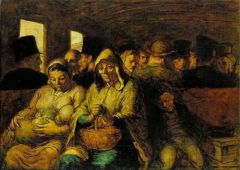
|
Daumier, "3rd Class Carriage", 1850, Realism
objective, just a train ride home, not a political event not a call for revolution, just an acknowledgment of reality |
|
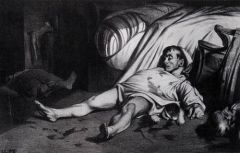
|
Daumier, "Rue de Transonain April 15th, 1850, Realism
sniper shot happened, police went into the building and killed everyone in the middle of the night PRINT, political pamphlet/critique matter of fact, (printmaking enhances this facet) repetition of form, shock value |
|
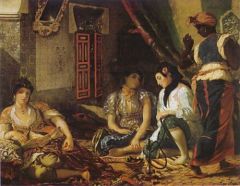
|
Delacroix, "Women of Algiers", 1850, Romanticism
exotic, women of harems, shown as more docile |
|
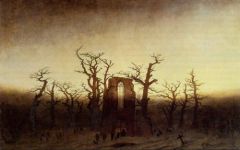
|
Friedrich, "Abbey in the Oak Forest", 1810, Romanticism
funeral procession through Gothik ruin, intense spirituality, mystery nature, men are small mean nurse |
|
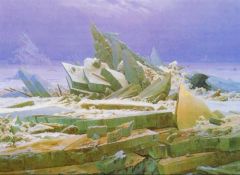
|
Friedrich, "Arctic Shipwreck", 1810, Romanticiscm
|
|

|
Friedrich, "Friar by the Sea", 1810, Romanticism
amorphous fog/blends with the sea fog gets lighter further up, hints at godliness friar is this enlightened religious guy, and even he is getting lost in the power of nature mean nurse |
|
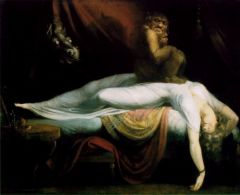
|
Fuseli, "The Nightmare", 1780, Early Romanticism
example of early shifting from reason, to emotion |
|
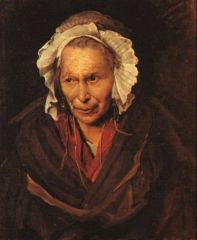
|
Gericault, "Insane woman", 1820, Romanticism
people went to insane asylums for the entertainment commissioned by a doctor, wanted to study them exotic, the OTHER looking for physical and mental correlations focus on the face, the individual |
|
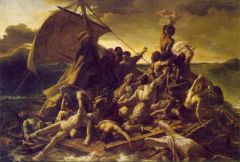
|
Gericault, "Raft of the Medusa", 1810, Romanticism
emotional, macabre, politically charged, power of nature triangular dead at bottom |
|
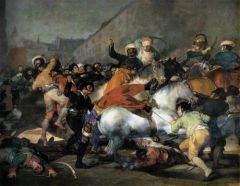
|
Goya, "2nd of May", 1800, Romanticism
uprising, retaliation, chaotic, emotional |
|
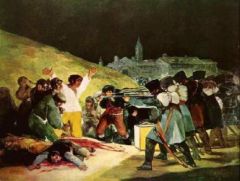
|
Goya, "3rd of May", 1800, Romanticism
uprising, retaliation, emotional civilian uprising |
|

|
Goya, "Saturn Devouring his Children", 1800, Romanticism
saturn looks terrified, painted in the dining room of his scary old house Black Paintings series |
|
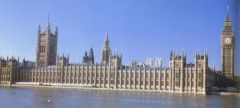
|
Barry and Pugin, "Houses of Parliament", 1830
revival architecture, gothic style to show moral/purity of government very horizontal, strong, stable, like English Gothic nationalism, patriotism |
|
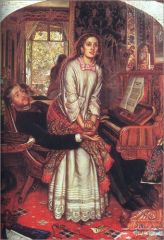
|
Hunt, "The Awakening Conscience", 1850, Pre-Raphaelite
disguised symbolism, mistress and her lover she has epiphany of her wasted life: song, open window, cat and bird etc. falling red robe w/ white under |
|
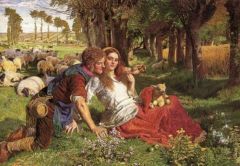
|
Hunt, "The Hireling Shephard", 1850, Pre-Raphaelite
disguised symbolism, he has stopped watching the sheep, become distracted, like man kind, by lust |
|
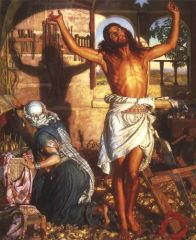
|
Hunt, "The Shadow of Death", 1850, Pre-Raphaelite
jesus as young carpenter, allegories, future-seeing |
|
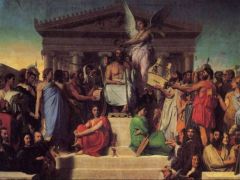
|
Ingres, "Apotheosis of Homer", 1830, Neoclassical/Romantic
brings up school of athens, victory crowning homer, historical thinkers/writers all around |
|
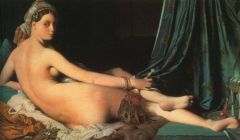
|
Ingres, "The Grande Odalisque", 1820, Romantic subject (exotic), neoclassical style
|
|

|
Nash, "Royal Pavilion" , 1850, Romanticism
exotic, escapist, india, inside is made up of 'all different cultures' |
|
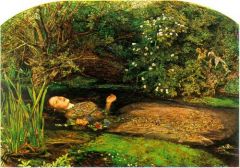
|
Millais, "Ophelia", 1850, Pre-Raphaelite
not a 'realist' subject, fictional old character but set in our reality |
|
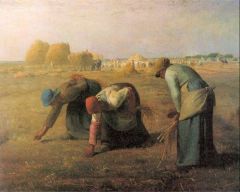
|
Millet, "The Gleaners" 1850, Realism
intense, extreme work for very little pay |
|

|
Rosetti, "The Annunciation", 1850, Pre-Raphaelite
Biblical themes, females with contrasting features |
|
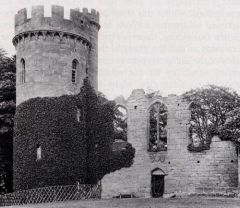
|
"Gothik Ruin", 1850, Romanticism
fake ruin, in a park built to give atmosphere |
|
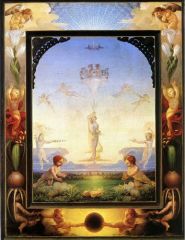
|
Runge, "Morning", 1810, Romanticism
connects nature and spirituality, part of a VERY fusion of the arts esque exhibition like stainedglass putti, composite religions, imagery= mary and roman goddess |
|

|
Turner, "Rain, Steam and Speed", 1850, Romanticism
wanted to recreated experience of sticking head out window blur=speed, his GOAL light/feathery brushstrokes little boat grounds piece, gives contrast to movement boat vs train is old vs new |
|
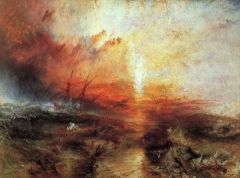
|
Turner, "Slave Ship", 1850, Romanticism
captain throws slaves overboard to get money mean nurse, political critique fury of nature |
|

|
Wapole, "Strawberry Hill", 1850, Romanticism
gothik revival, wanted a get away, fantasy country home world of knights/princesses reference to westminster abbey |

